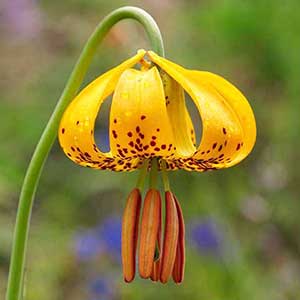Lilium columbianum
Lilium michiganense
Columbia lily, Columbia tiger lily, Columbian lily, Oregon lily, tiger lily
Michigan lily
variable, subrhizomatous to ± ovoid, 3.1–8.1 × 3.6–10.6 cm, 0.3–1.4 times taller than long;
scales 2–3(–5)-segmented, some unsegmented, longest 3.1–7.3 cm;
stem roots absent.
usually yellowish, rhizomatous, unbranched, 1.6–5.8 × 4.9–14.1 cm, 0.3–0.5 times taller than long, 2 years’ growth evident as annual bulbs, scaleless sections between these 2.6–6.2 cm;
scales unsegmented, longest 1–3 cm;
stem roots present or absent.
to 1.7 m, glaucous or not.
to 1.9 m. Buds rounded in cross section.
rounded in cross section.
in 1–9 whorls or partial whorls, 3–25 leaves per whorl, usually ascending, 1.7–15.7 × 0.4–4.7 cm, 2.4–7.4 times longer than wide;
blade weakly oblanceolate to obovate or ± elliptic, margins usually somewhat undulate, apex acute;
veins and margins ± smooth abaxially.
in 4–12 whorls or partial whorls, 3–13 leaves per whorl, ± horizontal or ascending in sun, drooping at tips, 4.6–15.3 × 0.6–2.3 cm, 3.5–13.7 times longer than wide;
blade narrowly elliptic, occasionally linear or slightly lanceolate, margins not undulate, apex acute, acuminate in distal leaves;
principal and some secondary veins impressed adaxially, veins and margins noticeably roughened abaxially with tiny ± deltoid epidermal spicules, especially on proximal leaves.
racemose, 1–25(–45)-flowered.
racemose, 1–11-flowered.
pendent to nodding, not fragrant;
perianth Turk’s-cap-shaped;
sepals and petals reflexed 2/5–1/2 along length from base, yellow or orange to occasionally red, with copious maroon spots, often darker and especially reddish abaxially, not distinctly clawed;
sepals not ridged abaxially, appearing wide for their length, 3.4–7.1 × 0.8–1.9 cm;
petals 3.5–6.9 × 0.8–1.9 cm;
stamens barely to moderately exserted;
filaments moderately spreading, diverging 10°–20° from axis;
anthers pale yellow to yellow, 0.5–1.3 cm;
pollen orange or yellow;
pistil 2.4–3.7 cm;
ovary 1.1–2.2 cm;
style green;
pedicel 2.8–20.2 cm.
± pendent, not fragrant;
perianth Turk’s-cap-shaped;
sepals and petals reflexed 1/4–2/5 along length from base, yellow-orange or sometimes orange-yellow or orange proximally, red-orange distally, with maroon, often large spots, red-orange or occasionally red or orange-red abaxially, not distinctly clawed;
sepals not ridged abaxially, 5.5–9.3 × 1.2–2 cm;
petals 5.3–9.1 × 1.5–2.2 cm;
stamens moderately exserted;
filaments parallel at first, then ± widely spreading, diverging 13°–23° from axis, pale yellow-green;
anthers magenta or occasionally pink-magenta, 0.6–1.3 cm;
pollen orange-rust, sometimes orange, rust, or rust-brown;
pistil 3.4–6.5 cm;
ovary 1.5–2.9 cm;
style red entirely or only distally;
pedicel 11–22 cm.
2.2–5.4 × 1.1–2 cm, 1.7–3.3 times longer than wide.
2.8–5 × 1.5–2.6 cm, 1.4–2.8 times longer than wide.
135–330.
not counted.
= 24.
= 24.
Lilium columbianum
Lilium michiganense
The author citations often seen for this species derive from Baker (1874), who published the name as Lilium columbianum “Hanson in hort., Leichtlin”; this authority is given by various later writers as Hanson, or Baker, or Hanson ex Baker. However, Ducharte’s (1871) recapitulation of a letter from M. Leichtlin is apparently the first confirmed and valid publication of L. columbianum, and hence that citation is used here.
This widespread lily is rather variable. In California plants the stamens are considerably less exserted than those of plants found farther north. Lilium columbianum may intergrade with L. kelloggii along Highway 199 at the border between California and Oregon; these plants are slightly fragrant, the stamens moderately exserted, and the bulb scales unsegmented. Lilium columbianum hybridizes with L. pardalinum subspp. wigginsii and vollmeri, and extensively with L. occidentale in Oregon.
Lilium columbianum is pollinated primarily by rufous hummingbirds [Selasphorus rufus (J. F. Gmelin), family Trochilidae] and to a lesser extent by large butterflies, including the pale swallowtail (Papilio eurymedon Lucas, family Papilionidae).
Native Americans used Lilium columbianum bulbs as a food or peppery condiment, sometimes mixed with meat or salmon roe. For many, it was a staple food (J. Pojar and A. MacKinnon 1994).
(Discussion copyrighted by Flora of North America; reprinted with permission.)
B. Boivin and W. J. Cody (1956) proposed uniting Lilium michiganense and L. superbum as subspecies of L. canadense on the basis of overall similarity, though it is now well accepted that L. superbum does not belong there. There can be little doubt as to the close relationship between L. michiganense and L. canadense, however, and vegetatively the two are often indistinguishable. Hybrid intermediates occur across a wide band where the distributions meet in central Ohio and northwestern New York (R. M. Adams and W. J. Dress 1982). It would not be unreasonable to include L. grayi and treat them as subspecies, but floral differences among the three are comparable to those between other species in the genus.
Farwell’s proposed varieties uniflorum and umbelliferum were described from young plants with single flowers and umbellate inflorescences respectively, but young plants with these characteristics are found throughout the range of this species.
Plants examined from east-central Tennessee (e.g., Wayne and Coffee counties) that were previously referred to Lilium michiganense are L. superbum in some cases, in others L. canadense perhaps introgressed with L. michiganense.
The Michigan lily often co-occurs in tallgrass prairies with Lilium philadelphicum; here as everywhere it usually blooms much later. However, it flowers earlier than L. canadense where their ranges are contiguous in Ohio (E. L. Braun 1967).
Lilium michiganense is pollinated primarily by swallowtail butterflies; in the southern part of its range these include the pipevine [Battus philenor (Linnaeus), family Papilionidae]. Great spangled fritillaries [Speyeria cybele (Fabricius), family Nymphalidae] also visit this species and carry its pollen, though it is unlikely that this brushfooted butterfly is a major pollinator.
(Discussion copyrighted by Flora of North America; reprinted with permission.)
- Local floras:
BC,
CA,
OR,
WA
- Local Web sites:
CalFlora,
CalPhotos,
Flora NW,
PNW Herbaria,
Turner Photog.
WildflowerSearch
iNaturalist (observations)
USDA Plants Database
- LBJ Wildflower Center
- SEINet
- Plants of the World Online
- Encyclopedia of Life
- Wikipedia
- Google Image Search


